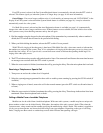- Indicates that encryption is enabled.
MON - Indicates that the monitor mode is enabled (conventional systems only). This mode is enabled by taking the
microphone off-hook or pressing the MON switch (if available). The monitor mode disables squelch control features
so that all messages are heard on the system. Refer to “Monitor Mode” description on page 11 for more information.
BUSY - On conventional systems only, this indicates when the selected system/group is busy. If this indication ap-
pears but no message is heard, Call Guard squelch is probably being used and a call was detected for someone else.
CALL - Indicates that a call was received while you were away from the vehicle. This indication can be programmed
so that it appears only when certain calls are received. It is turned off by pressing the Select switch, an option switch,
or the microphone push-to-talk switch, or by turning power off and then on again.
“
-” - The bar above the system and group digits indicate which digit will be changed if the Select switch is turned.
Refer to Select switch description in preceding section for more information.
STANDARD MOBILE-TO-MOBILE CALLS
Introduction
The standard mobile-to-mobile call is the type you will probably make most often. This type of call is between you
and another mobile or control station in your radio system. The main difference between this call and the telephone and
special calls described in the next section is that no number is dialed when it is placed.
Placing a Standard Mobile-To-Mobile Call
1. Turn power on and set the volume level if required.
2. If necessary, select the desired system/group using the front panel Select switch (see page x). The selected
system/group is displayed even when scanning.
3. If a conventional system is selected, the channel must be monitored before transmitting as described on page x.
4. Press the microphone PTT (push-to-talk) switch and operation is as follows with the various types of systems:
Multi-Net and LTR - If the short proceed tone sounds, the system is successfully accessed and speaking can begin.
Proceed to step 5.
If a busy condition exists, the busy tone sounds and “SYSTEM BSY” is displayed. If you keep the PTT switch
pressed, the system is accessed when it becomes available. Otherwise, try again later. If a Multi-Net system is selected
and the Busy Queuing feature is programmed (see page 13), the call goes into a queue when the PTT switch is released.
If an out-of-range condition exists, the intercept tone sounds and “OUT-OF-RNG” is displayed. Drive the vehicle
closer to the radio system or away from shielding structures and try again. If a Multi-Net system is selected and the
Auto-Registration feature is enabled, (see page 14), the transceiver automatically changes sites when an out-of-range
condition occurs.
Conventional - If the proceed tone has been enabled by programming, it sounds to indicate that speaking can begin.
However, the presence of this tone does not indicate that a busy or out-of-range condition does not exist (see “Con-
ventional Operation” on page 11).


















